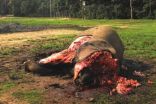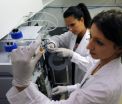(Press-News.org) Severe skin reactions during radiation therapy could be prevented by applying a thin transparent silicone dressing to the skin from the first day of treatment, clinical research from New Zealand shows.
Although many skincare products have been tested in clinical trials over the years, until now none have been able to completely prevent severe skin reactions, says senior lecturer Dr Patries Herst of University of Otago Wellington's Department of Radiation Therapy.
Dr Herst and her team of radiation therapists, oncology nurses and medical physicists have completed five randomised controlled clinical trials in public hospitals in Dunedin, Wellington, Palmerston North and Auckland Radiation Oncology over the past five years, all focusing on side effects caused by radiation therapy.
Their most recent trial was a close collaboration with Dunedin Hospital, and demonstrated it is possible to prevent skin reactions from developing in breast cancer patients undergoing radiation therapy.
Skin reactions are common in these patients, ranging from mild redness to ulceration with symptoms of pain, burning and itchiness, Dr Herst says.
"This can impact negatively on day-to-day life for patients who already have to cope with being diagnosed with and treated for cancer."
She is delighted with the results, and identification of a product that really works.
"This is fantastic news for cancer patients and it has put New Zealand firmly on the world map as a leader in clinical research into radiation-induced acute side effects."
The dressings work by adhering closely to the small folds in the skin without the use of adhesives, so do not stick to open wounds. By protecting the radiation-damaged skin from friction against items of clothing or other parts of the body, they allow the stem cells of the skin to heal from the radiation damage in an undisturbed environment. The dressings are also free of chemicals that could react with the skin.
Dr Herst is currently setting up a trial that will test the dressings in head and neck cancer patients.
INFORMATION:
The results have been published online in the international journal Radiotherapy and Oncology.
Skin reactions during radiation therapy preventable
2014-02-12
ELSE PRESS RELEASES FROM THIS DATE:
The genome of clonal raider ant provides a promising model to study social evolution and behavior
2014-02-12
Social insects, which usually have specialized behavioral groups (also called castes), are important models for social evolution and behavior researches. How division of labor in insect societies is regulated is an outstanding question and not fully understood yet. However, in many social insect species, experimental control over important factors that regulate division of labor, such as genotype and age, is limited. In a study published online on February 6th in Current Biology, researchers from Rockefeller University and BGI-Shenzhen have sequenced the genome of the queenless ...
Common infections linked to stroke in children; vaccines may reduce risk
2014-02-12
Common infections are associated with a significantly higher chance of stroke in children, but routine vaccinations may help decrease risk, according to preliminary research (abstract 39) presented at the American Stroke Association's International Stroke Conference 2014.
"The protective association of routine vaccination against childhood stroke provides a widely available means of prevention, and this information can easily be dispersed by pediatric healthcare providers," said Nancy Hills, Ph.D., M.B.A., lead researcher and assistant professor of neurology at the University ...
More awareness, fast response key to combatting stroke in children
2014-02-12
Parents and healthcare professionals must be aware that children can have strokes and be prepared to respond to symptoms, according to research presented at the American Stroke Association's International Stroke Conference 2014.
As in adults, warning signs of stroke in children are: sudden weakness or numbness of the face, arm or leg; sudden difficulty in speaking; sudden problems in seeing; sudden difficulty walking; dizziness; or sudden onset of headache.
Researchers interviewed 28 parents whose child had a stroke about factors that contributed to delayed arrival to ...
Cocaine may increase stroke risk within 24 hours of use
2014-02-12
Cocaine greatly increases ischemic stroke risk in young adults within 24 hours of use, according to research presented at the American Stroke Association's International Stroke Conference 2014.
Ischemic strokes occur when a blood vessel supplying blood to the brain becomes blocked, preventing a continuous supply of blood to the brain.
"We set out to understand what factors contribute to stroke risk in young adults," said Yu-Ching Cheng, Ph.D., research scientist at Baltimore Veterans Affairs Medical Center and assistant professor of medicine at the University of Maryland ...
Weather changes may be linked with stroke hospitalization, death
2014-02-12
Stroke hospitalization and death rates may rise and fall with changes in environmental temperature and dew point, according to research presented at the American Stroke Association's International Stroke Conference 2014.
"Weather is not something people would typically associate with stroke risk; however, we've found weather conditions are among the multiple factors that are associated with stroke hospitalizations," said Judith H. Lichtman, Ph.D., M.P.H., study author and an associate professor in Epidemiology at the Yale School of Public Health in New Haven, Conn.
Researchers ...
Lost and found: New beetle collected by Darwin 180 years ago published on his birthday
2014-02-12
In 1832 Charles Darwin disembarked from HMS Beagle in Bahia Blanca, Argentina where he travelled by land to Buenos Aires. In Bahia Blanca, Darwin collected several fossils of large mammals along with many other living organisms, including several insects. More than 180 years later on Darwin's birthday, February 12, scientists name after him a long lost but new to science beetle genus and species from this collection.
The beetle was discovered and described by Dr. Stylianos Chatzimanolis, an entomologist at the University of Tennessee at Chattanooga, USA as a new genus ...
Use of mortality as measure of stroke care questioned
2014-02-12
A new study disputes the effectiveness of mortality as a measure of the quality of care provided by hospitals to stroke patients. The paper – which was simultaneously presented today at the International Stroke Conference in San Diego and published in the journal Stroke – found that use of do-not-resuscitate (DNR) orders differ widely between hospitals and that this variation can significantly skew a hospital's quality "ranking" based on mortality.
"With mortality increasingly being used as a marker for the quality of care provided to stroke patients, it is essential ...
"You hide it -- I'll find it!" -- Great tit has a bird's eye view when looking for dinner
2014-02-12
Birds that hoard food for a rainy day better be sure that there are no great tits around to spy on where they hide their reserve of seeds and nuts. So says Anders Brodin and Utku Urhan of the University of Lund in Sweden, who found that great tits can remember the position of such hideaways up to 24 hours after seeing it cached. Interestingly, even though great tits share this mental ability with well-known hoarders such as crows and jays, they do not store up food themselves. The findings appear in Springer's journal Behavioral Ecology and Sociobiology.
Observations ...
New data shows continued decline of African forest elephants
2014-02-12
London (February 12, 2014)—New data from the field in Central Africa shows that between 2002 and 2013, 65 percent of forest elephants were killed. They are being poached, for their ivory, at a shocking 9 percent per year.
This new data marks an update to an earlier paper in the online journal PLOS ONE on the status of forest elephants across Central Africa, published by the same scientists. Many organisations collaborated in the study which covered 80 sites, in five countries, over the twelve years of data collection.
The earlier paper, published in 2013, already had ...
Capillaries will measure diffusion and help in more efficient medical treatment
2014-02-12
How strongly do two dissolved analytes react with each other? Such information is of paramount importance not only in chemistry and molecular biology, but also in medicine or pharmacy, where it is used, i.a., to determine optimal drug doses. A method developed in the Institute of Physical Chemistry of the Polish Academy of Sciences in Warsaw will allow for determining diffusion coefficients of analytes in fluids and equilibrium constants of reactions – quickly, at low cost, and most importantly: universally.
In many medical therapies, a prerequisite for efficient treatment ...


